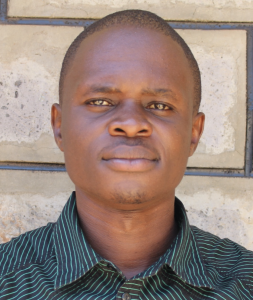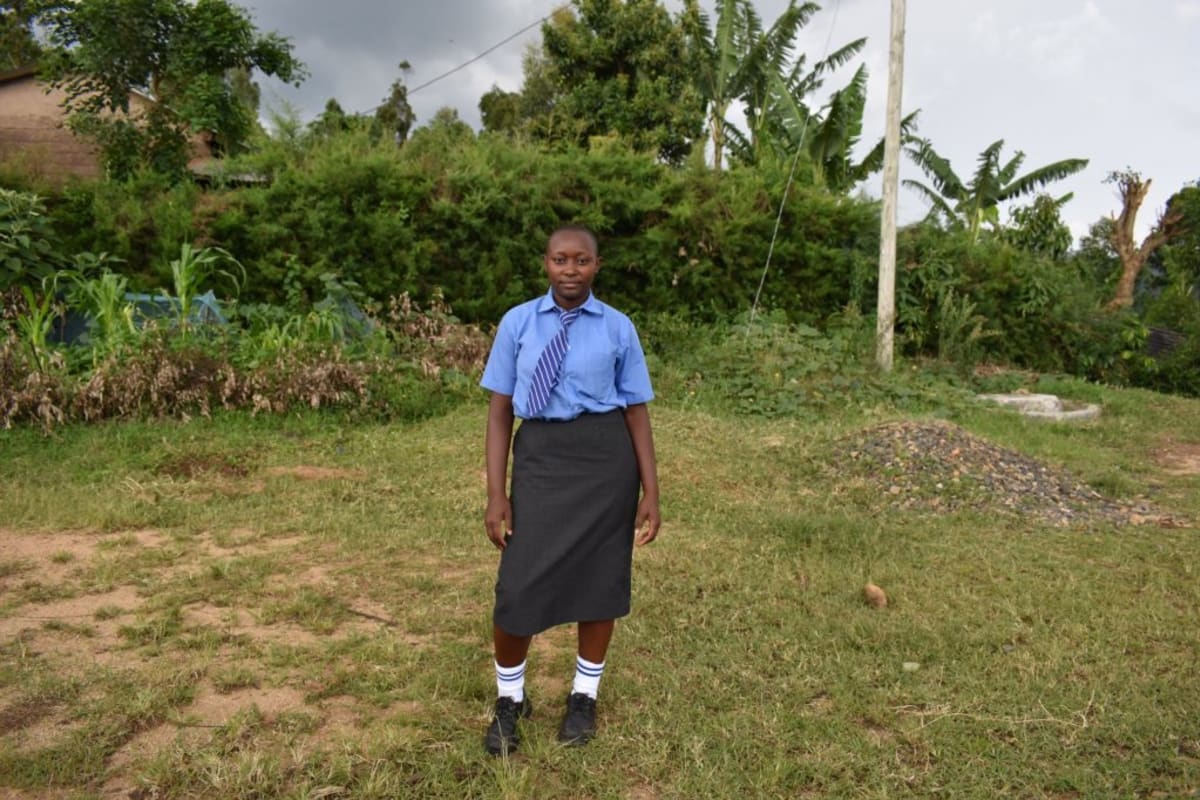August, 2020: Malinda Secondary School Project Complete!
Please note, all photos in this report were taken before COVID-19 prevention maesures went into effect in Kenya.
Malinda Secondary School in Kenya now has access to a new source of safe, clean water thanks to the completion of their rain tank, which has the ability to collect 75,000 liters of water! Before schools closed, we installed new latrines and handwashing stations for students, and we trained students and staff on improved sanitation and hygiene practices. All of these components work together to unlock the opportunity for these students to live better, healthier lives.

Students celebrate the rain tank.
Kenya’s president recently announced that due to the progression of COVID-19 in Kenya, all primary and secondary schools will remain closed until at least January 2021.
What does this mean for the project?
It’s simple: we will continue to maintain our water promise, monitoring the project’s integrity, and working with school officials to determine the best practices for the safety and maintenance of the rain tank and latrines. This will ensure that these new water and sanitation facilities stay in tip-top shape while awaiting the students' return. We are already counting down the months and days until we can greet these students back at school with their new rain tank and latrines!

Girls pose outside the entrance to the new VIP latrines.
Luckily, in addition to the health and hygiene training they received before schools closed in March, most students in this school live in communities where we have completed several rounds of COVID-19 sensitization training. We are continuing to work with all of the communities we serve throughout the pandemic to keep their water running and help them stay informed of the latest COVID-19 guidance.

A student celebrates clean water flowing from the rain tank's tap.
Curious about what life is like dealing with COVID-19 in a different country?
Check out our new series, “Through Their Eyes: COVID-19 Chronicles,” on our blog. Every week we invite a new person from a community we serve to share their perspective and experience since the pandemic came to their doorstep.
A New Page for Water & Sanitation at Malinda Secondary School
Construction for this 75,000-liter rain tank was successful!
Before schools closed, parents, staff, and students helped our artisans gather everything needed for construction. All the while, the school cooks and community members prepared meals for the artisans, and the school provided accommodations for the artisans during their work. Local women and men helped our artisans with their manual labor, too.

Students and their parents helped deliver water to school grounds for construction use.
The process officially began with our staff and school administration looking around the school compound to try and determine the best location for a new rain tank. This needed to be the best site with enough land and a nearby building with good, clean roofing to catch the rainwater.

Community members help prepare sand and gravel for use at the rain tank construction site.
Then, we cleared the site by excavating the soil to make level ground for the tank foundation. The foundation was cast by laying big stones on the level ground and reinforcing them using steel wire, concrete, and waterproof cement. We affixed both the drawing pipe and the drainage pipe as we laid the foundation.

Pouring the rain tank's concrete foundation over a layer of large stones and metal wire.
Next, we formed the outer walls using a skeleton of rebar and wire mesh with sugar sacks temporarily tied to the outside as backing. This skeleton was attached to the foundation’s edges so that the work team could start the Ferro-cementing process, in which the walls are layered with cement alternating with the inner and outer side until 6 layers of cement are in place. (We remove the sugar sacks once the interior receives its first 2 layers of cement.)

Interior cement and plasterwork dries on the rain tank walls and 5 support pillars.
Inside the tank, we cast 1 central and 4 support pillars to ensure the dome does not cave in once cemented. Meanwhile, we plastered the inner wall while roughcasting the outer walls. Outside of the tank, the access area to the tap was dug, plastered, and a short staircase installed, along with a soak pit where spilled water can drain from the access area through the ground. This helps to keep the tap area dry and tidy.

The artisan smooths a layer of exterior wall plaster.
Dome construction could begin after the tank walls had been given enough time to settle. Using similar techniques as used on the walls, the dome started as rebar, wire mesh, and sugar sacks and was attached to the tank walls before receiving cement and plaster. A small manhole cover was built into the dome to allow access for future cleanings and water treatments.

Sewing sugar sacks to wire to create the dome's skeleton.
Long wooden poles (about 75 of them!) were placed inside the tank to support the dome while it cured. A lockable manhole cover was fitted over the tap area, the gutters were affixed to the roof and the tank and an overflow pipe was set in place at the edge of the dome for when the tank reaches capacity.

Mid-way through fitting the dome's form to the rain tank walls before adding cement.
Once finished, the rain tank was given 3-4 weeks to undergo complete curing. Finally, the interior support poles and dome sugar sacks were removed, the tank was cleaned, and we waited as rain filled the tank with fresh water. When there was a sufficient volume in the tank, we treated the water and we officially handed it over to Malinda Secondary School.

Students celebrate clean water from the rain tank.
As soon as it was ready, students and staff celebrated the presence of clean water on campus. The event was a great chance for us to acknowledge the school administration and students as the primary parties entrusted with the tools we have given, as well as remind them of our continued support as they develop. Happiness, thanksgiving, and appreciation were the order of the day flowing in all directions.

A student holds up a cup of clean water for a drink from the tank.
"My life will improve to a great extent thanks to the installation of the rainwater tank in our school," said pupil Sheila.
"We really suffered going to fetch water outside the school's compound in a nearby spring and this entirely interrupted our normal class hours as much time was spent at the spring due to congestion. As a student of this school, I am thrilled that I will no longer have to go fetch water outside the school's compound just to have something to drink as I will be able to access clean, safe water directly in the school's compound. The construction of the tank will give me a chance to concentrate more on my studies and perform well in all my subjects."

Students fetch water from the rain tank.
Teachers were just as excited as the students about the new rain tank on campus.
"The quality of life of people is threatened by the unavailability of clean, safe water. Installation of this water point will go a long way in improving the hygiene standards of the school. Beneficiaries will now access water directly in the school compound," said school Principal Charles Shikuku.
"Installation of this water point will save academic time as the students will be able to access clean, safe water much faster and easily, directly in the school's compound. We also expect high enrollment in the future and an improvement in the overall performance of the school. Cases of absenteeism will reduce as lack of water in school was the major reason [for this before]."

The Water and Sanitation Teacher poses next to the rain tank.
VIP Latrines
This project funded the installation of 6 new ventilated improved pit (VIP) latrines, half for girls, and half for boys. All of these new latrines have cement floors that are designed to be easy to use and clean, locking doors for safety and privacy, and vents designed to keep air flowing up and out through the roof. With a rain tank right on school property, there should be enough water to keep them clean.

Boys pose next to the new VIP latrines.
Handwashing Stations
We set up 2 new handwashing stations during training and handed them over to the student health club. We placed these stations outside of the girls’ and boys’ latrines to encourage handwashing after latrine use. Health club members will teach other students how to properly wash their hands at the stations, make sure the stations are filled with water, and work to ensure that there is always soap available.

Students show a new handwashing station in action.
New Knowledge
Hygiene and sanitation training was scheduled with the help of the school principal, who ensured that the training date would be convenient for students, staff, and parent representatives. Individual teachers helped by selecting students from each class to represent the others. When the training day arrived, facilitators Olivia Bomji, Victor Musemi, and Samuel Simidi deployed to the site.

Trainer Olivia explains the solar disinfection method of water treatment using a water bottle example.
13 students and 1 teacher attended training, which we held under a tree to allow for concentration as the sun that day was hot. Being a young school, the attendance was positive as we had planned to train 14 students who were to be ambassadors of the health and hygiene training to the rest of the student body.

A student builds a leaky tin handwashing station as part of the practical sessions at training.
Because we held this training before the first case of COVID-19 was was confirmed in Kenya, this was not a topic we covered. Since then, however, we have developed trainings exclusively on COVID-19 prevention and awareness. See how we continue to fight COVID-19 on the frontlines in all of the communities we serve.

Practicing the 10 steps of handwashing with Trainer Victor.
We covered a number of other topics including personal hygiene such as bathing, oral hygiene, and the 10 steps of handwashing; environmental hygiene; child rights; operation and maintenance of the rain tank, latrines, and handwashing stations; and leadership and governance. During the latter, the students elected their peers to lead their newly formed student health club.

Handwashing practical.
The club will be greatly involved in the water, sanitation, and hygiene project management at school and will be responsible for encouraging good health and hygiene practices amongst their peers, teachers, and the larger community. We involved stretches, dances, and physical activities in between each topic to keep the pupils’ energy up and their minds active. By the end of the training, each pupil understood their role in sustaining clean water and good health within their school community.

Handwashing practical
One of the most memorable topics covered, the facilitators reported, was the role of gender in water, hygiene, and sanitation-related issues. This session was important to ensure that all individuals, regardless of their age and gender, benefit from improved WASH facilities. It was noted during the training that poor access of water and sanitation facilities can increase the vulnerability of women and girls especially when trying to access these services as they are frequently the primary caregivers in a household. Women and girls are also typically responsible for teaching their children good habits from a young age, as well as taking responsibility for their family's good health. Everyone had something to learn and to share during this topic.

Students take notes at training.
"I am very grateful and happy having been selected as one of the participants for the training. Today's training has been enriching to me as one of the participants and I believe my hygiene and sanitation standards will improve," said pupil Faith.

A student takes a drink of water from the rain tank.
When an issue arises concerning the water project, the students and teachers are equipped with the necessary skills to rectify the problem and ensure the water point works appropriately. However, if the issue is beyond their capabilities, they can contact our team of field officers to assist them. In addition, we will continue to offer them unmatchable support as a part of our ongoing monitoring and maintenance program.

Until the students return, we will keep monitoring their rain tank and VIP latrines to make sure they are ready for the school's use come January.
Thank you for making all of this possible!


 Rainwater Catchment
Rainwater Catchment
 Rehabilitation Project
Rehabilitation Project

















































